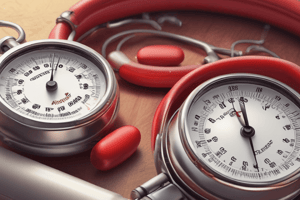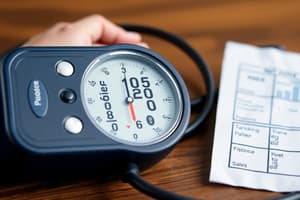Podcast
Questions and Answers
What is the main cause of primary hypertension?
What is the main cause of primary hypertension?
- Weight gain
- No identifiable cause (correct)
- Adrenal tumors
- Kidney disorders
Which lifestyle change can specifically lower systolic blood pressure by about 10 mmHg?
Which lifestyle change can specifically lower systolic blood pressure by about 10 mmHg?
- Regular moderate exercise (correct)
- Weight loss
- Quitting smoking
- Reducing sodium intake
What does the term 'hypotension' refer to?
What does the term 'hypotension' refer to?
- Fluctuating blood pressure
- Low blood pressure (correct)
- Normal blood pressure
- High blood pressure
Which of the following is a common treatment for hypertension that works by reducing blood volume?
Which of the following is a common treatment for hypertension that works by reducing blood volume?
Which of the following factors is NOT associated with lowering hypertension risk?
Which of the following factors is NOT associated with lowering hypertension risk?
Which condition is typically caused by secondary hypertension?
Which condition is typically caused by secondary hypertension?
What is an effect of hypertension on the heart?
What is an effect of hypertension on the heart?
Which medical procedure involves the removal of plaque from the carotid artery?
Which medical procedure involves the removal of plaque from the carotid artery?
What mechanism allows tissues to regulate their own blood flow based on metabolic needs?
What mechanism allows tissues to regulate their own blood flow based on metabolic needs?
Which system promotes vasodilation and decreases blood pressure?
Which system promotes vasodilation and decreases blood pressure?
Which hormone is known for being a potent vasoconstrictor?
Which hormone is known for being a potent vasoconstrictor?
What is the relationship between blood flow velocity and the cross-sectional area of blood vessels?
What is the relationship between blood flow velocity and the cross-sectional area of blood vessels?
Which factors determine blood flow aside from blood pressure?
Which factors determine blood flow aside from blood pressure?
What is the formula for calculating cardiac output?
What is the formula for calculating cardiac output?
How does resistance affect blood flow?
How does resistance affect blood flow?
What happens to blood pressure as it leaves the aorta and travels through systemic circulation?
What happens to blood pressure as it leaves the aorta and travels through systemic circulation?
What is the primary function of capillaries in the circulatory system?
What is the primary function of capillaries in the circulatory system?
Which type of blood vessel is primarily responsible for carrying deoxygenated blood back to the heart?
Which type of blood vessel is primarily responsible for carrying deoxygenated blood back to the heart?
What distinguishes elastic arteries from muscular arteries?
What distinguishes elastic arteries from muscular arteries?
Which structure of arteries is primarily responsible for regulation of blood pressure?
Which structure of arteries is primarily responsible for regulation of blood pressure?
What type of capillaries would you find in the kidneys that allow greater molecule passage?
What type of capillaries would you find in the kidneys that allow greater molecule passage?
What mechanism do blood vessels mainly use to regulate blood flow?
What mechanism do blood vessels mainly use to regulate blood flow?
What is the primary structural difference between venules and capillaries?
What is the primary structural difference between venules and capillaries?
What role do valves in veins play in blood circulation?
What role do valves in veins play in blood circulation?
What primarily helps maintain blood return to the heart?
What primarily helps maintain blood return to the heart?
Which circulatory route carries deoxygenated blood from the heart to the lungs?
Which circulatory route carries deoxygenated blood from the heart to the lungs?
What is the function of the foramen ovale in fetal circulation?
What is the function of the foramen ovale in fetal circulation?
What occurs during the postnatal changes in fetal circulation?
What occurs during the postnatal changes in fetal circulation?
What role does the cardiovascular center in the medulla oblongata play?
What role does the cardiovascular center in the medulla oblongata play?
During which stage does the umbilical vein carry oxygenated blood?
During which stage does the umbilical vein carry oxygenated blood?
What is the main purpose of the ductus arteriosus during fetal development?
What is the main purpose of the ductus arteriosus during fetal development?
What kind of receptors provide input to the cardiovascular center?
What kind of receptors provide input to the cardiovascular center?
What is the primary function of venules in the circulatory system?
What is the primary function of venules in the circulatory system?
Which of the following correctly describes varicose veins?
Which of the following correctly describes varicose veins?
What is the definition of hydrostatic pressure in the context of capillary exchange?
What is the definition of hydrostatic pressure in the context of capillary exchange?
Which statement is true regarding Starling's Law of the Capillaries?
Which statement is true regarding Starling's Law of the Capillaries?
What is the primary factor that determines blood flow through the vessels?
What is the primary factor that determines blood flow through the vessels?
Which of the following factors does NOT influence blood pressure?
Which of the following factors does NOT influence blood pressure?
What occurs to blood flow velocity as the total cross-sectional area increases?
What occurs to blood flow velocity as the total cross-sectional area increases?
What is the relationship between mean arterial pressure (MAP) and cardiac output (CO)?
What is the relationship between mean arterial pressure (MAP) and cardiac output (CO)?
Flashcards are hidden until you start studying
Study Notes
Hypertension
- Hypertension affects about 50 million Americans, leading to heart failure, kidney disease, and stroke.
- Normal blood pressure is 100 mmHg.
- 90-95% of hypertension cases are primary, with no identifiable cause.
- 5-10% of hypertension cases are secondary, with identifiable causes like kidney disorders and adrenal tumors.
- Hypertension damages blood vessels by thickening them, causing atherosclerosis, and increasing resistance.
- Hypertension increases the workload on the heart, leading to myocardial hypertrophy and potential heart failure.
- Hypertension increases the risk of stroke due to vessel rupture.
- Hypertension damages arterioles in the kidneys, worsening hypertension.
Lifestyle Changes for Hypertension
- Weight loss is effective in reducing blood pressure.
- Moderate alcohol consumption may lower the risk of coronary heart disease.
- Regular moderate exercise can lower systolic pressure by about 10 mmHg.
- High-salt diets can worsen hypertension, so reducing sodium intake is important.
- Maintaining potassium, calcium, and magnesium levels is associated with a lower risk of hypertension.
- Quitting smoking reduces heart damage.
- Stress management techniques like meditation can help lower blood pressure.
Drug Treatments for Hypertension
- Diuretics reduce blood volume by increasing urine output.
- ACE inhibitors block angiotensin II formation, promoting vasodilation.
- Beta blockers decrease heart rate and renin secretion.
- Vasodilators relax arterial smooth muscle, lowering resistance.
- Calcium channel blockers slow calcium entry, reducing heart workload.
Blood Vessels Structure and Function
- Blood vessels transport oxygenated blood away from the heart through arteries and arterioles.
- Capillaries are the exchange site for oxygen, carbon dioxide, nutrients, and waste.
- Venules and veins carry deoxygenated blood back to the heart.
- Arteries have three layers: Tunica Interna (lining), Tunica Media (smooth muscle and elastic fibers), and Tunica Externa (connective tissue).
- Arteries are classified as elastic (high elastin content) and muscular (more smooth muscle).
- Arterioles regulate blood flow and pressure.
- Capillaries have a single layer of endothelial cells for diffusion and are classified as continuous, fenestrated, and sinusoidal.
- Venules collect blood from capillaries.
- Veins have thinner walls and a larger lumen than arteries, and contain valves to prevent backflow.
Blood Flow Regulation
- Autoregulation allows tissues to regulate their own blood flow based on metabolic needs.
- The sympathetic nervous system activates vasoconstriction, increasing blood pressure.
- The parasympathetic nervous system promotes vasodilation, decreasing blood pressure.
- Hormones like epinephrine, norepinephrine, angiotensin II, and atrial natriuretic peptide influence blood vessel function.
Capillary Exchange
- Diffusion, transcytosis, and bulk flow are the mechanisms for capillary exchange.
- Starling's Law of Capillaries balances fluid movement through hydrostatic and osmotic pressures.
Hemodynamics
- Blood pressure is the force exerted by circulating blood on vessel walls.
- Cardiac output is the volume of blood pumped by the heart per minute.
- Blood flow velocity is inversely related to the cross-sectional area of blood vessels.
- Blood pressure and resistance determine blood flow.
- Venous return is influenced by pressure differences, skeletal muscle contractions, venous valves, and respiratory pressure changes.
Circulatory Routes
- Systemic circulation carries oxygenated blood from the left side of the heart to the body and back as deoxygenated blood.
- Pulmonary circulation carries deoxygenated blood from the right side of the heart to the lungs and back as oxygenated blood.
- Fetal circulation features unique routes bypassing non-functioning organs, as the fetus receives oxygen through the placenta.
Fetal Circulation
- Umbilical vein carries oxygenated blood from the placenta to the fetus.
- Ductus venosus shunts a portion of umbilical vein blood directly to the inferior vena cava, bypassing the liver.
- Foramen ovale is an opening between the right and left atria allowing blood to bypass the non-functioning fetal lungs.
- Ductus arteriosus connects the pulmonary artery to the aorta, allowing blood to flow directly to the systemic circulation.
Postnatal Circulation
- At birth, the umbilical cord clamping stops blood flow from the placenta.
- Foramen ovale closure redirects blood flow through the lungs.
- Ductus arteriosus constriction becomes a ligament.
Control of Blood Pressure and Blood Flow
- The cardiovascular center in the medulla oblongata regulates heart rate, contractility, and blood vessel diameter.
- The cardiovascular center receives input from higher brain regions and sensory receptors.
- Output from the cardiovascular center travels along sympathetic and parasympathetic axons.
Venules and Veins
- Venules collect blood from capillaries.
- Veins have thinner walls and a larger lumen than arteries.
- Veins contain valves to prevent backflow of blood.
- Varicose veins occur due to weak valves leading to blood pooling.
Vascular Sinuses
- Vascular sinuses are thin-walled veins that allow for significant blood volume storage.
Blood Reservoirs
- Systemic veins serve as reservoirs, particularly in the liver, spleen, and skin.
Studying That Suits You
Use AI to generate personalized quizzes and flashcards to suit your learning preferences.




